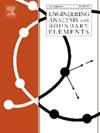BEM formulation for simulating heat dissipation in microelectronic packaging with point heat sources
IF 4.2
2区 工程技术
Q1 ENGINEERING, MULTIDISCIPLINARY
Engineering Analysis with Boundary Elements
Pub Date : 2025-02-01
DOI:10.1016/j.enganabound.2024.106076
引用次数: 0
Abstract
This work presents a new and robust formulation for studying the effect of point heat sources on three-dimensional thermomechanical contact problems. The aim of this work is to accurately analyze heat dissipation in microchips with known heat sources. To achieve this, the Boundary Element Method (BEM) has been used to calculate the thermomechanical influence coefficients. The traditional BEM has been extended in the proposed formulation to account for the complex interactions between the microchip and heatsink, which result from the inclusion of point heat sources. This includes the effects of microcontacts, microgaps, and thermal contact resistance. To solve the problem’s inherent non-linearity, a dual iterative solution scheme has been proposed. The formulation is validated by a numerical example and is shown to be capable of accurately capturing traction variations in the contact zone and the influence of heat sources on the contact zone temperature. The formulation is then applied to study the thermomechanical behavior of microelectronic packages, particularly those with low heat dissipation, under the influence of simulated point heat sources.
点热源微电子封装散热模拟的边界元计算公式
本研究提出了一种新的稳健公式,用于研究点热源对三维热机械接触问题的影响。这项工作的目的是精确分析具有已知热源的微芯片的散热情况。为此,采用了边界元素法(BEM)来计算热机械影响系数。传统的 BEM 已在建议的公式中进行了扩展,以考虑微芯片和散热器之间复杂的相互作用,这是由包含点热源造成的。这包括微接触、微间隙和热接触电阻的影响。为了解决该问题固有的非线性问题,我们提出了一个双迭代求解方案。该方案通过一个数值示例进行了验证,证明能够准确捕捉接触区的牵引力变化以及热源对接触区温度的影响。然后将该公式应用于研究微电子封装,尤其是低散热封装在模拟点热源影响下的热力学行为。
本文章由计算机程序翻译,如有差异,请以英文原文为准。
求助全文
约1分钟内获得全文
求助全文
来源期刊

Engineering Analysis with Boundary Elements
工程技术-工程:综合
CiteScore
5.50
自引率
18.20%
发文量
368
审稿时长
56 days
期刊介绍:
This journal is specifically dedicated to the dissemination of the latest developments of new engineering analysis techniques using boundary elements and other mesh reduction methods.
Boundary element (BEM) and mesh reduction methods (MRM) are very active areas of research with the techniques being applied to solve increasingly complex problems. The journal stresses the importance of these applications as well as their computational aspects, reliability and robustness.
The main criteria for publication will be the originality of the work being reported, its potential usefulness and applications of the methods to new fields.
In addition to regular issues, the journal publishes a series of special issues dealing with specific areas of current research.
The journal has, for many years, provided a channel of communication between academics and industrial researchers working in mesh reduction methods
Fields Covered:
• Boundary Element Methods (BEM)
• Mesh Reduction Methods (MRM)
• Meshless Methods
• Integral Equations
• Applications of BEM/MRM in Engineering
• Numerical Methods related to BEM/MRM
• Computational Techniques
• Combination of Different Methods
• Advanced Formulations.
 求助内容:
求助内容: 应助结果提醒方式:
应助结果提醒方式:


